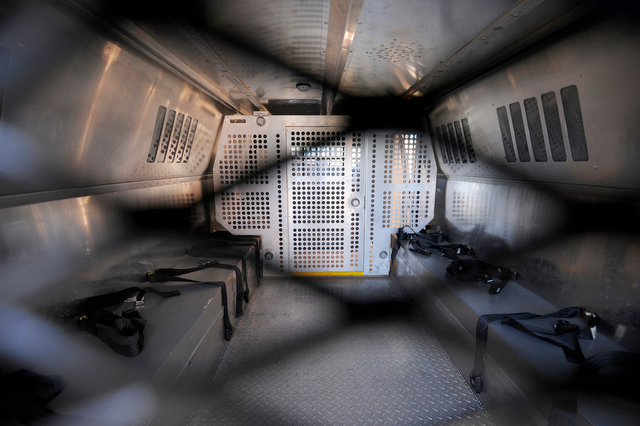Undocumented Immigrant Bailed Out of ICE
Jailed Without Priors, Part of Tougher Immigration Policies

An immigration judge at Adelanto Detention Facility recently granted $7,500 bail for an undocumented Santa Barbara landscaper who was picked up by ICE agents two months ago after spending the night in County Jail. Charges, it turned out, were never filed, and he had no priors. Nevertheless, the Sheriff’s Office notified ICE (Immigration and Customs Enforcement) of the time they would release him from jail. ICE agents waited for him at the entrance and transported him to Adelanto.
The case is just one example of toughened immigration enforcement under President Donald Trump. According to Trump’s immigration priorities, the Department of Homeland Security “will not exempt classes or categories of removable aliens from potential enforcement.”
The case unfolded one night in May. Jose’s wife of 17 years said she impulsively called the police while they were arguing about money in the street in front of their downtown apartment. Even though she hung up, “Marissa” said, the dispatcher called back. When the police showed up, “Jose” believed the whole thing was a prank, according to Marissa. (The Santa Barbara Independent agreed not to publish the real names of the individuals involved.)
Marissa told the officers she did not want to press charges, but California law requires police to arrest suspects in incidents reported as “domestic violence.” Exactly what happened that night is unclear. Marissa was adamant Jose did not touch her, but others familiar with the episode said he might have joked to the police that he did.
Marissa works as a housekeeper; Jose had landscaping jobs. The couple have three kids under age 13 who were all born in Mexico and go to public schools. They have a number of extended relatives in the community. In June, Marissa’s father died of a chronic disease at a Los Angeles hospital. Santa Barbara’s Our Lady of Guadalupe was packed for the memorial service.
Before he got out of Adelanto earlier this week, Jose spent the last two months in detention. There, about 500 inmates are awaiting trial, which is an administrative process. Attorney Jeremy Frost noted that “serious criminal aliens” are usually transferred there. Asked what conditions were like, he said, “It’s a prison, what can I tell you?”
Though Jose has not been available for an interview, relatives relayed they were worried he would not have the “aguante” — Spanish for stamina — to survive very long at Adelanto.
There are several ways to bail out of the detention center. The inmate can pay the amount in full or put down 20 percent payment and collateral, such as property or a credit card. One company, Libre by Nexus, issues ankle monitors for inmates who might not have collateral. They have to pay $120 per month until their case is resolved. Carpinteria immigration attorney Marisol Alacon expressed mixed feelings about the device. Although she called the monitoring process “horrendous,” she recognized some people might not otherwise have the means to get out. “Some families are living paycheck to paycheck,” she said.
It is unclear the way that Jose bailed out of ICE. In any case, the good news for him is that it’s easier to fight an immigration case when out of custody. It also takes much longer — three to five years. Frost is requesting to transfer the case to a Los Angeles court. The next appearance date has not been set.
(Last month, funds in the state budget were set aside for the California Department of Justice to evaluate the conditions of the state’s immigration detention facilities. The effort was spearheaded by State Senator Ricardo Lara (D-Bell Gardens) and California Attorney General Xavier Becerra. A report is expected by March 2019.)
The process by which county sheriffs’ offices interact with ICE agents has become the subject of swelling contention. Inmates booked in county jails have their fingerprints taken, which are entered in a federal system. Should an individual appear not to have papers, the inmate is flagged. ICE agents might request an interview in custody (which the inmate could refuse). ICE agents also have unfettered access to the sheriffs’ databases.
Statistics about the number of inmates turned over to ICE agents has been hard to come by. Sheriff Bill Brown recently released data for 2016. That year, ICE requested that sheriff’s custody staff notify them when 620 foreign-born inmates were going to be released. Of those, ICE agents took 258 inmates into custody, according to Brown. Of the arrestees, 29 were convicted of assault, 16 of burglary, 34 for “dangerous drug,” 30 for domestic violence, and 30 for traffic offenses (DUI). Two hundred people were ultimately deported.
When asked, Brown said they did not track ICE referrals in past years. He explained ICE agents do not pick up everyone they request information about. “This could be due to their staffing constraints, or because they interviewed the person and were no longer interested in them,” he said in a recent email. He noted simple drug possession charges are now misdemeanors, meaning they would probably not be booked in jail.
Repeated requests on information about ICE pickups at Santa Barbara County Jail this year was not made available by ICE.


